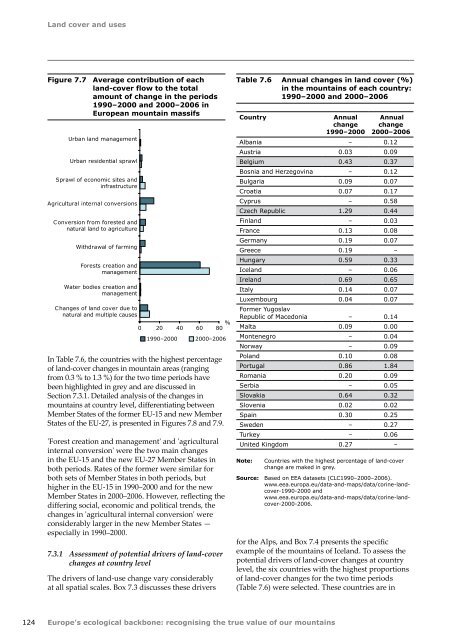Europes ecological backbone.pdf
Europes ecological backbone.pdf
Europes ecological backbone.pdf
You also want an ePaper? Increase the reach of your titles
YUMPU automatically turns print PDFs into web optimized ePapers that Google loves.
Land cover and uses<br />
Figure 7.7 Average contribution of each<br />
land‐cover flow to the total<br />
amount of change in the periods<br />
1990–2000 and 2000–2006 in<br />
European mountain massifs<br />
Urban land management<br />
Urban residential sprawl<br />
Sprawl of economic sites and<br />
infrastructure<br />
Agricultural internal conversions<br />
Conversion from forested and<br />
natural land to agriculture<br />
Withdrawal of farming<br />
Forests creation and<br />
management<br />
Water bodies creation and<br />
management<br />
Changes of land cover due to<br />
natural and multiple causes<br />
%<br />
0 20 40 60 80<br />
1990–2000 2000–2006<br />
In Table 7.6, the countries with the highest percentage<br />
of land‐cover changes in mountain areas (ranging<br />
from 0.3 % to 1.3 %) for the two time periods have<br />
been highlighted in grey and are discussed in<br />
Section 7.3.1. Detailed analysis of the changes in<br />
mountains at country level, differentiating between<br />
Member States of the former EU‐15 and new Member<br />
States of the EU‐27, is presented in Figures 7.8 and 7.9.<br />
'Forest creation and management' and 'agricultural<br />
internal conversion' were the two main changes<br />
in the EU‐15 and the new EU‐27 Member States in<br />
both periods. Rates of the former were similar for<br />
both sets of Member States in both periods, but<br />
higher in the EU‐15 in 1990–2000 and for the new<br />
Member States in 2000–2006. However, reflecting the<br />
differing social, economic and political trends, the<br />
changes in 'agricultural internal conversion' were<br />
considerably larger in the new Member States —<br />
especially in 1990–2000.<br />
7.3.1 Assessment of potential drivers of land‐cover<br />
changes at country level<br />
The drivers of land-use change vary considerably<br />
at all spatial scales. Box 7.3 discusses these drivers<br />
Table 7.6 Annual changes in land cover (%)<br />
in the mountains of each country:<br />
1990–2000 and 2000–2006<br />
Country<br />
Annual<br />
change<br />
1990–2000<br />
Annual<br />
change<br />
2000–2006<br />
Albania – 0.12<br />
Austria 0.03 0.09<br />
Belgium 0.43 0.37<br />
Bosnia and Herzegovina – 0.12<br />
Bulgaria 0.09 0.07<br />
Croatia 0.07 0.17<br />
Cyprus – 0.58<br />
Czech Republic 1.29 0.44<br />
Finland – 0.03<br />
France 0.13 0.08<br />
Germany 0.19 0.07<br />
Greece 0.19 –<br />
Hungary 0.59 0.33<br />
Iceland – 0.06<br />
Ireland 0.69 0.65<br />
Italy 0.14 0.07<br />
Luxembourg 0.04 0.07<br />
Former Yugoslav<br />
Republic of Macedonia – 0.14<br />
Malta 0.09 0.00<br />
Montenegro – 0.04<br />
Norway – 0.09<br />
Poland 0.10 0.08<br />
Portugal 0.86 1.84<br />
Romania 0.20 0.09<br />
Serbia – 0.05<br />
Slovakia 0.64 0.32<br />
Slovenia 0.02 0.02<br />
Spain 0.30 0.25<br />
Sweden – 0.27<br />
Turkey – 0.06<br />
United Kingdom 0.27 –<br />
Note:<br />
Countries with the highest percentage of land-cover<br />
change are maked in grey.<br />
Source: Based on EEA datasets (CLC1990–2000–2006).<br />
www.eea.europa.eu/data-and-maps/data/corine-landcover-1990-2000<br />
and<br />
www.eea.europa.eu/data-and-maps/data/corine-landcover-2000-2006.<br />
for the Alps, and Box 7.4 presents the specific<br />
example of the mountains of Iceland. To assess the<br />
potential drivers of land‐cover changes at country<br />
level, the six countries with the highest proportions<br />
of land‐cover changes for the two time periods<br />
(Table 7.6) were selected. These countries are in<br />
124 Europe's <strong>ecological</strong> <strong>backbone</strong>: recognising the true value of our mountains

















